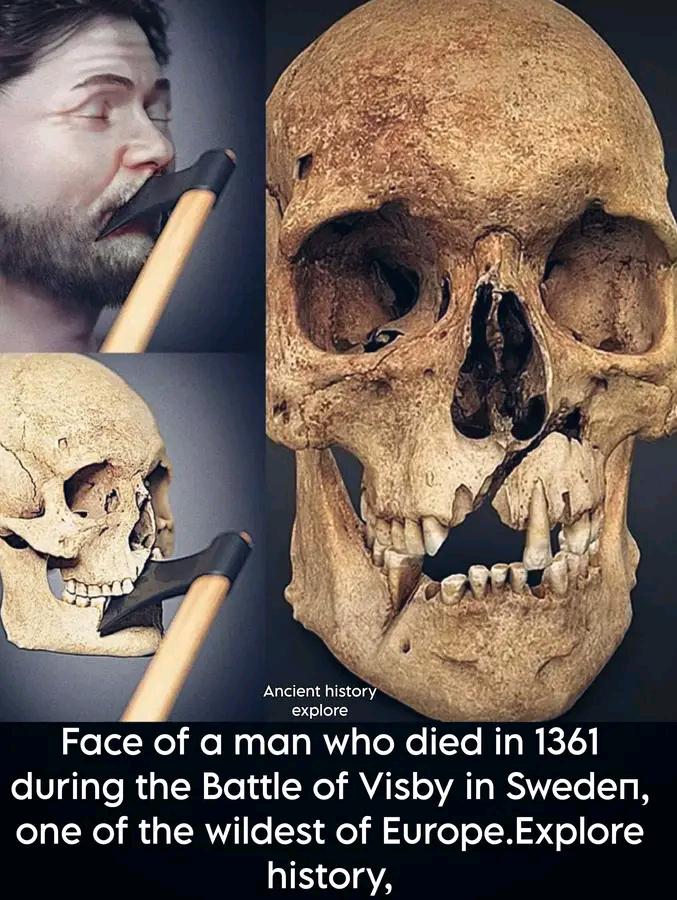The Battle of Visby, fought in 1361 on the Swedish island of Gotland, was one of the most brutal and memorable conflicts in European history. The face of a man who perished in this battle serves as a haunting reminder of the fierce and often chaotic nature of medieval warfare.
The battle occurred during the Danish invasion led by King Valdemar IV, where the defenders of Visby, mainly composed of local farmers and townsfolk, faced off against a well-equipped Danish army. The gruesome aftermath of the battle saw the bodies of nearly 2,000 defenders hastily buried outside the city walls, many of whom were still in their armor.
Archaeological excavations in the 20th century unearthed these mass graves, revealing well-preserved remains that provided invaluable insights into the lives and deaths of those who fought. The face of the man discovered among these remains is particularly striking, as it allows us to connect with an individual from centuries past, giving a human face to the often-abstract narratives of history.
This discovery not only highlights the brutality of the Battle of Visby but also serves as a poignant reminder of the human cost of conflict. The preservation of these remains, along with the weapons and armor found alongside them, has made the Battle of Visby a crucial site for the study of medieval warfare and the social history of the time.
Exploring such moments in history through photography and media allows us to better understand the past, bringing us closer to the individuals who lived, fought, and died in these pivotal events. Through platforms like @historyperplex, we can continue to learn and appreciate the rich tapestry of human history, one story at a time.
If you're passionate about history and archaeology, following such pages can provide daily content that educates and inspires, connecting us with the ancient past and the lessons it holds for the present and future.
The battle occurred during the Danish invasion led by King Valdemar IV, where the defenders of Visby, mainly composed of local farmers and townsfolk, faced off against a well-equipped Danish army. The gruesome aftermath of the battle saw the bodies of nearly 2,000 defenders hastily buried outside the city walls, many of whom were still in their armor.
Archaeological excavations in the 20th century unearthed these mass graves, revealing well-preserved remains that provided invaluable insights into the lives and deaths of those who fought. The face of the man discovered among these remains is particularly striking, as it allows us to connect with an individual from centuries past, giving a human face to the often-abstract narratives of history.
This discovery not only highlights the brutality of the Battle of Visby but also serves as a poignant reminder of the human cost of conflict. The preservation of these remains, along with the weapons and armor found alongside them, has made the Battle of Visby a crucial site for the study of medieval warfare and the social history of the time.
Exploring such moments in history through photography and media allows us to better understand the past, bringing us closer to the individuals who lived, fought, and died in these pivotal events. Through platforms like @historyperplex, we can continue to learn and appreciate the rich tapestry of human history, one story at a time.
If you're passionate about history and archaeology, following such pages can provide daily content that educates and inspires, connecting us with the ancient past and the lessons it holds for the present and future.
The Battle of Visby, fought in 1361 on the Swedish island of Gotland, was one of the most brutal and memorable conflicts in European history. The face of a man who perished in this battle serves as a haunting reminder of the fierce and often chaotic nature of medieval warfare.
The battle occurred during the Danish invasion led by King Valdemar IV, where the defenders of Visby, mainly composed of local farmers and townsfolk, faced off against a well-equipped Danish army. The gruesome aftermath of the battle saw the bodies of nearly 2,000 defenders hastily buried outside the city walls, many of whom were still in their armor.
Archaeological excavations in the 20th century unearthed these mass graves, revealing well-preserved remains that provided invaluable insights into the lives and deaths of those who fought. The face of the man discovered among these remains is particularly striking, as it allows us to connect with an individual from centuries past, giving a human face to the often-abstract narratives of history.
This discovery not only highlights the brutality of the Battle of Visby but also serves as a poignant reminder of the human cost of conflict. The preservation of these remains, along with the weapons and armor found alongside them, has made the Battle of Visby a crucial site for the study of medieval warfare and the social history of the time.
Exploring such moments in history through photography and media allows us to better understand the past, bringing us closer to the individuals who lived, fought, and died in these pivotal events. Through platforms like @historyperplex, we can continue to learn and appreciate the rich tapestry of human history, one story at a time.
If you're passionate about history and archaeology, following such pages can provide daily content that educates and inspires, connecting us with the ancient past and the lessons it holds for the present and future.
0 Comments
·0 Shares
·0 Reviews



